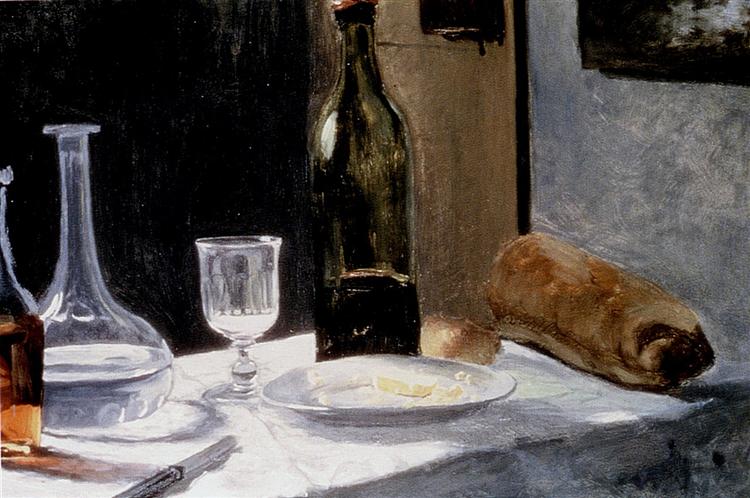Beschreibung
Claude Monet's painting "Still Life with Bottles" (1863) represents an early stage in the Impressionist master's career, where one can already glimpse the exploration of light and form that would characterize his later work. In this composition, Monet exhibits a meticulous arrangement of various objects on a wooden surface, where the bottles stand as the main characters of the scene. The selection of elements, which includes bottles of different shapes and sizes, stands out in an austere but carefully arranged frame, allowing for an introspective study of the object.
The work displays a use of colour that is both vibrant and restrained, with a palette that combines dark and light tones in a visual dialogue that invites contemplation. The bottles, mostly in shades of green, brown and blue, become reflections and emanate an organic feeling reminiscent of everyday life, while the warmer-toned backgrounds contrast elegantly with the cold ones of the bottles, creating a depth that is characteristic of Monet’s pictorial approach. This chromatic interplay not only captures the essence of the objects depicted, but also reveals a studied play of light and shadow, giving the work a realism that defies the simplicity of a still life.
The presence of the table surface, rich in brown hues and textures, complements the work by providing a solid context in which the objects are harmoniously arranged. This clear and direct approach to composition is a departure from the more traditional methods of a still life, where fruits or flowers often predominate. Here, Monet seems more interested in capturing the essence of the materials and their interaction with light than in creating a more elaborate narrative.
Part of the Impressionist movement that Monet would eventually lead, Still Life with Bottles shows the beginnings of his artistic thinking, where the study of light and color become the champions of his representations. The objects in the work are not simply static forms; they are visual records of an atmosphere, of a moment caught in time. This interest in the effects of light, which would define his career, begins to be hinted at in the subtle handling of the technique of loose brushstrokes that allow the viewer to feel the vivacity of each nuance and form.
Although not one of his most widely recognized works, Still Life with Bottles provides a fascinating insight into Monet's evolution as a painter and his transition to Impressionism. In a broader context, it is interesting to compare it with other still lifes of the period, which tend to explore the ephemeral and the situated in the everyday environment, but often within a more rigid and conventional framework. Through this work, Monet not only offers us a clear insight into his technical skill, but also an innovative proposition that will be fundamental in the writing of the modern pictorial language.
In short, Still Life with Bottles is a testament to the forward-thinking genius of Claude Monet, a precursor of Impressionism who began to play with perception and light in ways that challenged artistic tradition. The work, despite its apparent simplicity, reveals itself as a microcosm of the visual exploration that would characterize not only Monet's work, but an entire movement that would change the trajectory of painting in the years to come.
KUADROS ©, a famous painting on your wall.
Hand-made oil painting reproductions, with the quality of professional artists and the distinctive seal of KUADROS ©.
Painting reproduction service with satisfaction guarantee. If you are not completely satisfied with the replica of your painting, we will refund 100% of your money.

